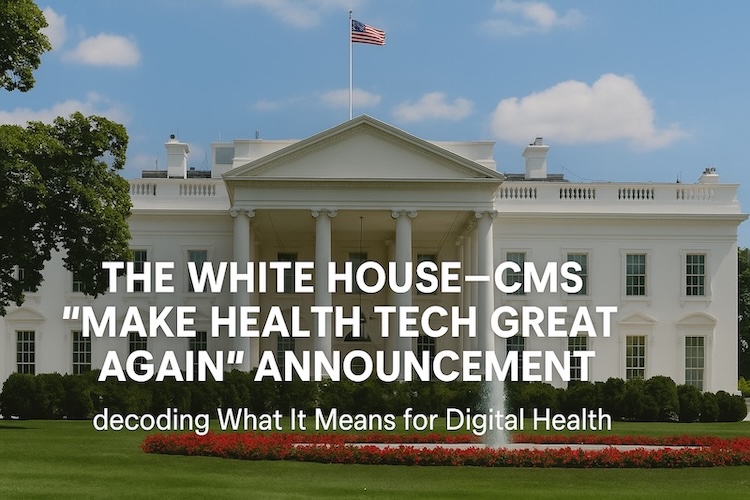On 30 July 2025, the White House and Centers for Medicare & Medicaid Services (CMS) announced a voluntary CMS Interoperability Framework, a commitment to create CMS-Aligned Networks, and a suite of upgrades to identity, directories, and data access in U.S. healthcare.
Key features include:
- Faster Blue Button 2.0 APIs for Medicare data access and patient data retrieval
- Digital insurance cards for seamless patient verification
- Expanded Data at the Point of Care services
- A FHIR-based National Provider Directory
- Enhancements to Medicare.gov Plan Finder
- A nationwide “kill the clipboard” push for digital patient intake
Over 60 organisations pledged support, with 21 networks signalling their intent to meet the criteria. CMS projects that early patient- and provider-initiated data sharing through aligned networks could begin as soon as Q1 2026.
This is not simply a policy update—it represents a structural shift in digital health interoperability. For the first time, CMS is integrating its own assets (Blue Button, provider directories, identity systems) into a national-scale, patient-centred, identity-anchored interoperability framework.
What This Really Changes in Digital Health Interoperability
Historically, digital health interoperability in the U.S. has been framed as a compliance burden—a requirement to be met for regulatory purposes. This announcement reframes it as a market opportunity and a competitive differentiator.
By:
- Defining voluntary criteria,
- Publicly listing CMS-Aligned Networks, and
- Embedding CMS-owned tools into the CMS interoperability framework,
…the U.S. government is creating a reputational and distribution flywheel for FHIR-native healthcare data exchange.
Participation becomes a commercial advantage—a way to accelerate procurement cycles, win RFPs, and increase market trust.
Buyers will shift from asking:
“Do you support FHIR?”
…to: “What’s your query success rate, latency, and uptime across CMS-Aligned Networks?”
This transition moves from checkbox compliance to performance-driven interoperability—rewarding those who can prove real-world, measurable outcomes.
Ten Market Shifts to Watch in the CMS-Aligned Networks Era
1) Interoperability Becomes a Market Discipline
When data exchange performance is visible—completion rates, latency, error budgets—vendors compete on outcomes, not just capability claims. Procurement language will evolve from “Are you FHIR-compatible?” to “Show your performance benchmarks.”
This shifts value to companies such as Redox with middleware integration or Health Gorilla in clinical data exchange. It also compresses sales cycles for solutions that “just work” on the rails, while increasing the cost of bespoke integrations.
2) Standards Shift from Paperwork to Product Design
Identity assurance, directory hygiene, consent orchestration and auditability will become first-class product features, with early-movers such as Zus Health becoming increasingly essential in the ecosystem. Teams that treat them as late-stage security/compliance tasks will lag on enterprise readiness and time-to-value. Conversely, products designed around portable identity, clean provider endpoints and revocable consent can move across organisations with fewer legal and IT bottlenecks.
3) Workflows Become the Unit of Competition
If access and identity become table stakes, the battleground moves to end-to-end workflows that reduce time, clicks and denials: digital intake, eligibility, scheduling, prior authorisation light, Rx start/expand, remote monitoring enrolment. Winners will prove measurable throughput gains (minutes saved, denials avoided, gaps closed) that finance can recognise, not just better UX. Persivia is an example company that is taking advantage of AI capabilities to revolutionise data management and patient care.
4) Evidence and Reimbursement Clarity Tighten the Funding Funnel
Capital will concentrate around models that turn data liquidity into reimbursable revenue via existing codes (RPM/RTM), PMPM, value-based arrangements or outcomes-linked pricing. “Engagement-only” propositions without payer-validated economics will find it harder to raise. Expect a larger role for real-world evidence generated on these rails and faster product-market feedback cycles.
5) Data Governance Becomes a Competitive Capability
As more data moves, the system’s weakest governance links will be exposed: stale directories, identity collisions, sloppy consent UX, and undercooked breach response. Organisations that operationalise stewardship (clear ownership, audit trails, rapid revocation, transparent incident comms) will become preferred counterparties. Those that do not will face reputational and regulatory headwinds.
6) Distribution Patterns Rewire
“CMS-Aligned” participation creates network effects. A single integration can now reach multiple buyers, magnifying the role of platforms, EHR app marketplaces, and HINs. Channel power will accrue to entities that bundle rail-readiness, procurement shortcuts and co-selling motions. Startups that demonstrate portability across networks will scale faster; incumbents that wall off data will face buyer resistance.
7) Labour and Skills Mix Changes
Front-of-house teams see administrative relief as clipboards disappear; back-of-house shifts toward data quality, identity resolution and consent management. New roles will blend clinical operations with data engineering and privacy UX. Training and change management become strategic, not optional. Northwell Health already started this shift by appointing Kristin Myers as its first Executive Vice President & Chief Digital Officer in January 2024, consolidating digital health strategy across clinical operations, patient experience, and cloud infrastructure. Her role underscores that digital transformation isn’t an IT project—it’s an enterprise strategy that cuts across governance, clinical workflows, and patient engagement.
8) Consumer Trust and Equity as Rate-Limiters
The ecosystem can only move as fast as public trust allows. Explicit, plain-language permissions, easy revocation, and visible access logs are essential to sustain participation, especially for Medicare populations. Identity requirements must include assisted pathways to avoid excluding those without mobile IDs or high digital literacy, or the rails will widen disparities instead of narrowing them. Multilingual and multicultural aspects will play a role in including the diverse population.
9) International Spillovers Shape Vendor Strategy
A U.S. push at this scale will influence global buyers and standards bodies. Multinational vendors will bias roadmaps toward identity-first, FHIR-native design that travels. Expect more cross-border pilots to reuse the same consent and directory patterns, and for investors to favour platforms that can replicate the model in other regulated markets. At the same time, it will open the door to international players that are accustomed to cross-border interoperability to enter the U.S. due to the complexity of state-specific healthcare standards and broad cultural differences. Ada Health is an example of a European company that has successfully migrated into the U.S. thanks to its multi-national focus.
10) Transparency Loops Reshape Incentives
If CMS and networks publish usage and performance scorecards, sunlight becomes a policy tool. Vendors and buyers will optimise for what is measured—stimulating continuous improvement in directory accuracy, response times, and successful data retrieval. Public benchmarks also raise the bar on privacy incidents, pushing the market toward conservative defaults and faster remediation.
Bottom line: the centre of gravity moves from siloed, project-by-project integrations to a shared, identity-anchored operating fabric. That fabric doesn’t guarantee success; it lowers the cost of doing the right thing.
Ecosystem winners—investors, startups, providers, payors and patient-advocacy groups—will be the ones who design for these rails, prove value with hard metrics, and build trust with privacy that’s visible, simple and real.
The Pragmatic ‘So What’ for Stakeholders
This initiative won’t erase fragmentation overnight. But it resets the default: identity-anchored, FHIR-native healthcare data exchange becomes the easiest route for buyers and developers.
- Investors: Double down on rails-native, outcomes-verified models.
- Startups: Build to the CMS Interoperability Framework and target CMS-Aligned Network buyers.
- Health systems & payors: Turn data governance into a competitive advantage.
- Patients: Expect better control and fewer barriers—if privacy is protected.
The decisive moment will come in 2026, when aligned networks either show credible adoption and performance or reveal the need for stronger incentives.
If successful, this could mark the first time U.S. digital health feels truly consumer-grade—powered by a national infrastructure that lowers the cost of doing the right thing.
Why HealthTech Alpha Gives You the Edge in the CMS-Aligned Era
HealthTech Alpha is Galen Growth’s purpose-built digital health intelligence platform that delivers clinically grounded, real-time market data and evidence-based analytics to help investors, providers, and innovators identify winners, benchmark performance, and make faster, better decisions.
In a market shifting to performance-first digital health interoperability, data alone is not enough—stakeholders need context-rich, clinically validated insights.
HealthTech Alpha is purpose-built for this.
- Comprehensive Scope: Tracks the global digital health investment landscape, from early-stage startups to multinational incumbents, mapped to a clinically grounded taxonomy.
- Evidence-Based Scoring: Proprietary metrics such as Evidence Signal (ES), Alpha Score, and funding momentum show a venture’s readiness to thrive on CMS-Aligned Networks.
- Real-Time Tracking: Continuous ingestion of market, funding, and adoption data—human-audited for accuracy—keeps users ahead of trends in FHIR-based interoperability.
- Strategic Clarity: Enables investors, providers, payors, and innovators to identify winners early, mitigate risks, and benchmark governance and digital health interoperability performance.
As procurement decisions increasingly rely on observable performance and real-world evidence, HealthTech Alpha offers the fastest route to actionable market intelligence—turning regulatory change into competitive advantage.
The CMS Interoperability Framework bottom line:
The CMS Interoperability Framework signals a new era for U.S. healthcare—one where the winners will be those who design for, operate on, and prove value across CMS-Aligned Networks. The time to prepare is now, and the most forward-thinking organisations are already using HealthTech Alpha to guide their strategies.








